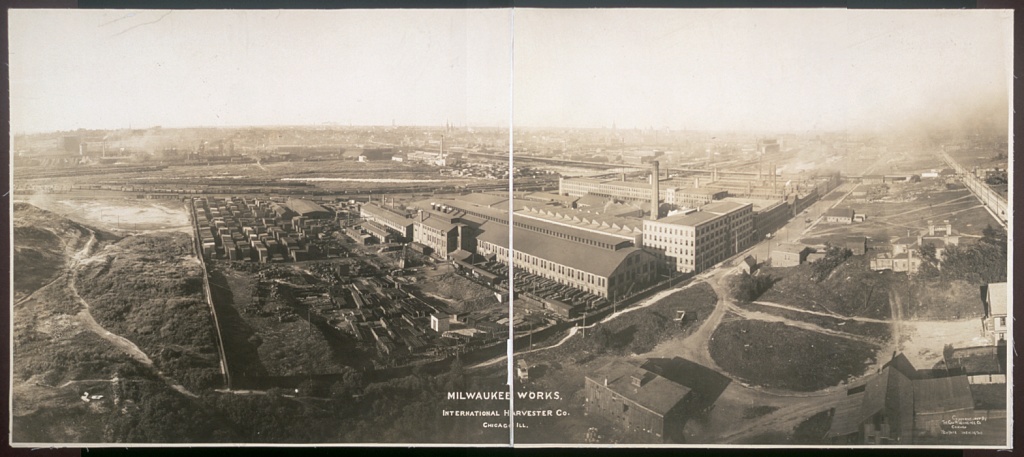In the late nineteenth and early twentieth centuries, Wisconsin was a leading producer of farm implements.[1] One of the major contributors to this growing industry was International Harvester, which was active in Milwaukee for nearly a century. Long before the Milwaukee plant became a part of an international conglomerate, it was Milwaukee Harvester—a local operation specializing in twine binders, mowers and harvesters.[2] The company enjoyed financial success through much of the 1880s and 1890s. It was courted by a number of other states hoping to entice the growing business into relocating but remained a Milwaukee institution from 1881 to 1971.[3] As market competition increased, however, Milwaukee Harvester joined with four other “principal manufacturers of harvesting machines in the United States” to form International Harvester in 1902.[4] The new entity dominated this market, producing approximately ninety percent of the country’s grain binders and eighty percent of its mowers.[5]
Over time, the Milwaukee Works branch of International Harvester developed an expansive production site at the south end of the Menomonee Valley. It included numerous three- and four-story buildings, and employed several hundred workers in its early years.[6] Throughout the first half of the twentieth century, production diversified and the Milwaukee plant eventually came to specialize in the manufacture of engines and cream separators, in addition to other agricultural implements.[7]
Like most other local businesses, International Harvester shifted its focus to war production once America entered World War II. Milwaukee workers produced torpedo parts, gun carriages, and other war materiel.[8] Operations expanded exponentially, and at the height of war the company employed over 8,000 men and women. (To accommodate such a workforce, by the time it closed the Milwaukee Works covered over 35 acres.)[9] The war’s end, however, brought drastic cutbacks in production which forced the company to lay off 2,000 workers.[10]
Unlike other local manufacturing giants, International Harvester failed to weather the postwar storm. The workforce continued to decline throughout the 1950s and by 1961 had dipped to 3,000.[11] In that year, the company began moving various parts of its operations, including the forge shop and sheet metal manufacture away from Milwaukee. Just four years later the machine shop closed, and all that remained was the foundry. Like many factories that relocated to the non-union Sunbelt states, the International Harvester foundry in Milwaukee finalized what had been an on-going process by moving the remaining production to its Louisville, Kentucky works in 1971. Company officials emphasized that the move was a result of the modern facilities available at the Louisville Works rather than wages. While the International Harvester foundry in Waukesha was able to accommodate some of the employees, the plant closure in Milwaukee led to the elimination of nearly 700 jobs in the city.[12]
Footnotes [+]
- ^ J.H.H. Alexander, “A Short Industrial History of Wisconsin,” Wisconsin Blue Book (Madison: Industrial Commission, 1929), 35-36. See also John D. Buenker, The History of Wisconsin, Vol. IV, The Progressive Era, 1893-1914 (Madison: Wisconsin Historical Society, 1998). According to Buenker, the Wisconsin tool industry “virtually quadrupled” between 1889 and 1914 (104).
- ^ Milwaukee, A Half Century’s Progress, 1846-1896: A Review of the Cream City’s Wonderful Growth and Development from Incorporation until the Present Time (s.l.: Consolidated Illustrating Company, 1896), 116. According to various sources, the company began in 1876 as Parker and Stone in Beloit, Wisconsin. Later name changes included Parker & Dennett and Beloit Harvester and Binders. The company moved to Milwaukee in 1881 and changed its name to Milwaukee Harvester in 1884. See McCormick-IH Chronology 148 A.D.-1971, Company Chronology Milwaukee 1876-1879, Wisconsin Historical Society website, last accessed March 31, 2017, and Luther Conant and U.S. Bureau of Corporations, “The International Harvester Co., March 3, 1913” (Washington, DC: Government Printing Office, 1913), 48 and 68.
- ^ “May Leave the City: Milwaukee Harvester Company Has a Flattering Offer,” Milwaukee Journal, June 6, 1892, 3.
- ^ Conant, “The International Harvester Co.,” xvii.
- ^ Conant, “The International Harvester Co.,” xvii.
- ^ Milwaukee, A Half Century’s Progress, 116.
- ^ Gordon M. Winder, The American Reaper: Harvesting Networks and Technology, 1830-1910 (Burlington, VT: Ashgate Publishing, Ltd., 2013), 131.
- ^ “Harvester Co. Job Cut Plan Rouses Union,” Milwaukee Journal, November 27, 1945, 1.
- ^ “International Harvester to Close Last Plant Here,” Milwaukee Journal, August 20, 1971, 19.
- ^ “Harvester Co. Job Cut Plan Rouses Union,” 1.
- ^ “International Harvester to Close Last Plant Here.”
- ^ “International Harvester to Close Last Plant Here.”
For Further Reading
Durr, Kenneth, and Lee Sullivan. International Harvester, McCormick, Navistar: Milestones in the Company that Helped Build America. Portland: Graphic Arts Center Publishing, 2007.
International Harvester Company. History and Development of International Harvester. Chicago: The Company, 1966.
Marsh, Barbara. A Corporate Tragedy: The Agony of International Harvester Company. New York: Doubleday, 1985.

0 Comments
Please keep your community civil. All comments must follow the Encyclopedia of Milwaukee Community rules and terms of use, and will be moderated prior to posting. Encyclopedia of Milwaukee reserves the right to use the comments we receive, in whole or in part, and to use the commenter's name and location, in any medium. See also the Copyright, Privacy, and Terms & Conditions.
Have a suggestion for a new topic? Please use the Site Contact Form.